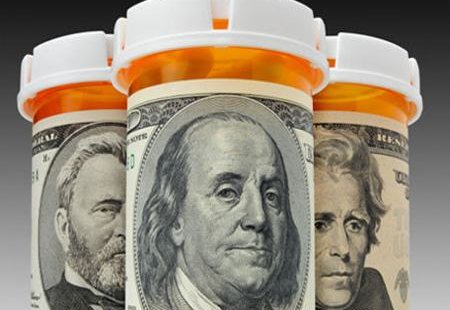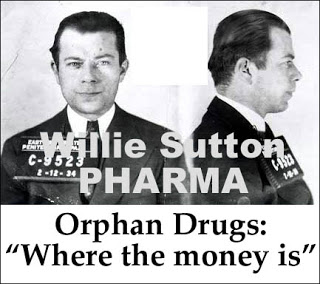My most recent blog post on the “Race for the Cure” For Myotonic Dystrophy drugs and a potential cure had stated that the market size that is reachable for this disease is between 2-5 Billion dollars. Today a recent Wall St. Journal Article “The Big Business of Orphan Drugs” confirms that the market for These type of Orphan Drugs is extremely lucrative for companies and patients alike. Read about Small is Lucrative for Drug Companies. The Wall St. Journal article of course is not available without a Subscription.
The Wall street journal reported that incentives from the FDA to develop so called orphan drugs can mean quicker and more certain approval, tax benefits for the developer, and seven years of protection from competition after approval. Orphan drugs are defined as experimental treatments for disease with fewer than 200,000 patients at one time.
Big Pharma has watched Shire and other firms such as Isis Pharmaceuticals develop drugs that have gone on to reach sales of hundreds of millions if not billions of dollars. And Big Pharma is following suit. Isis is of course stealthy developing and is in the lead for human trials with its myotonic dystrophy anti-sense approach. The difference with this drug will most likely be its low development cost. Several of the researchers in the field have found that the approaches to eliminate the foci causing the disease are “Unusually sensitive” to the antisense approach. That should mean lower development costs for myotonic dystrophy cures. Additionally the therapy last a long period of time so that the cost per time period should be low leading to larger gross profit potential.
The orphan drug industry has seen impressive growth in recent years, with global sales of $84.9 billion in 2009. As a result, tremendous attention is now being paid to the orphan market. In FY 2011, the FDA approved 35 innovative new drugs, almost one-third (10) for orphan disorders. For innovators and support providers, it is important to understand how these markets are developed, supported, and grown.
In the United States, orphan drugs are defined as therapies that treat fewer than 200,000 patients. This market has been further segmented into “ultra-orphan,” which represents fewer than 20,000 patients.
I would suggest that ultra-orphan is even better defined as markets of fewer than 6000 patients. The National Institutes of Health lists approximately 6000 rare diseases. According to Tufts research, about 83% of these disorders affect fewer than 6000 patients. Thus, a large part of the rare or orphan marketplace is really made up of small patient populations. This is an important distinction because markets of a few hundred to a few thousand patients are completely different from larger markets of 50,000 to 200,000 and they require a different approach.
Orphan drug development has several advantages1:
- It takes just under 5 years from Phase 2 clinical trial to market, as opposed to 6 to 8 years for traditional drug approval
- Orphan designations have better odds for approval with an 82% success rate (Phase 2 forward) as opposed to 35% for traditional drugs
- Orphan products have attractive profitability given the smaller patient populations, which drive premium pricing and lower cost of sales
- Orphan products experience ongoing revenue growth due to steady uptake after launch with chronic, lifetime customers
- Orphan products experience significant competitive advantage to being first to market
FOR BIG PHARMA: THE NEW FRONTIER?
In recent years, the largest pharmaceutical companies have started to compete to acquire a limited pool of promising orphan/ultra-orphan projects. They also have undertaken initiatives to enlist the trust and support of raredisease patient groups. This trend has been driven by a number of factors1:
- Many blockbuster drugs are close to patent expiration and will be replaced by generics
- Drug development pipelines have been dwindling
- The risks and costs of bringing a traditional drug to market are astronomical
- By comparison, orphan drugs require smaller clinical trials, receive tax incentives, and experience fast-track regulatory review. Thus, orphan drugs can cost less to develop and have a higher price tag than conventional drugs, making them ideal replacements
With the increasing presence of these high-profile manufacturers in this unique marketplace, a greater allocation of resources for research and treatment in the orphan market space is inevitable, creating enormous opportunities.
CHALLENGES
While the orphan market offers an attractive future for both pharma and specialty pharmacies, it is not without its challenges. The challenges in the orphan drug space include:
- Clinical trial end points and lack of biomarkers
- Difficulty identifying patients
- Growing regulatory issues and demands
- Changing reimbursement environment
- Outdated distribution models
Let’s examine each of these challenges.
CLINICAL DEVELOPMENT
Performing clinical studies in rare diseases can be challenging. Identification of trial subjects can be difficult depending on qualification criteria and a small pool of subjects. By nature, these trials will be small and subject to variations experienced by just a few participants. Comorbidities associated with most rare diseases also can confound the results. Additionally, well-defined end points and suitable biomarkers can be difficult to establish. Finally, many drug candidates may require years to produce a meaningful, measurable result such as a slowing of the normal progression of a disorder.
REGULATORY HURDLES
Despite these challenges, many new orphan drugs are on their way to submission and most qualify for fast-track review. Once at the FDA, approval may come with strings attached in the form of Risk Evaluation and Mitigation Strategies (REMS) requirements. REMS are used by the FDA to provide a higher level of comfort around safety and are especially attractive when trials are performed on small numbers of patients.
Currently, there is much discussion of a “progressive approval pathway” for drugs that treat rare diseases with a strong unmet need. A key component of this is the use of strong REMS to closely monitor the drug in a limited environment. While clearing the way for faster approvals, REMS requirements will impact manufacturers, providers, and specialty pharmacies in a very meaningful way.
INCREASING REIMBURSEMENT SCRUTINY
In the past, orphan drug prices received little attention from payers. Because the markets are so small and the number of approved drugs so few, the impact to a single payer was acceptable. However, as the number of orphan drugs grows and the impact of the overall specialty spend is felt, orphan drugs are unlikely to remain under the radar. According to the National Institutes of Health, by 2030 specialty pharmacy costs (which include orphan drugs) will exceed $1 trillion a year and account for as much as 44% of health plans’ total drug expenditure if current trends continue. With an average therapy cost of $150,000 annually, orphan drugs are drawing more and more attention from payers.
DISTRIBUTION CHALLENGES
The distribution and support of ultraorphan products requires a different approach from the current prevalent specialty pharmacy models. The industry has gone through an unprecedented period of aggregation to large, highly automated, efficient mail environments. These operations developed in response to large-market specialty therapies in multiple sclerosis, rheumatoid arthritis, hepatitis C, growth disorders, psoriasis, etc, where an efficient, low-cost delivery model made sense due to the growing cost associated with these categories. Along with oncology, these markets make up the bulk of specialty costs to payers. Continued margin pressure and pressure to control the burgeoning specialty spend are driving these specialty pharmacy operations to become even more efficient.
The unfortunate result is a focus on efficiency and cost-cutting that often comes at the expense of service. As a result, the small market sizes and high service requirements associated with ultra-orphan products have caused both patient communities and drug innovators to seek more meaningful solutions. In this lies the opportunity for specialty pharmacy to meet the needs of a new market by revisiting its roots.
BACK TO THE FUTURE
Specialty pharmacy’s roots lie in the late 1980s, when “home care” emerged as a viable alternative to treating patients in a clinical setting. Early specialty pharmacy models evolved in association with blood products (hemophilia, IVIG) as well as TPN and antibiotic therapy. These highly competitive home care pharmacies developed patient-support models that recognized the impact of the disorder on the patient and their families, and offered high-touch, personal support that was meaningful to them. These are the same type of services the market is seeking in association with new orphan products.
THE ORPHAN DIFFERENCE
The successful specialty pharmacy of the future will understand that the effects of orphan diseases can be devastating for patients and family. The impact of these disorders goes beyond the physical manifestations of the disease to include economic burden on family, decreased social functioning, decreased productivity (both patient and caregivers), and lowered quality of life. Specialty pharmacy should use this understanding to develop support programs that are meaningful and help their patients (and caregivers) to live better lives, not just deliver therapy. It is important to understand that many of these patients will be patients for life. As such, building a trust relationship through meaningful support and understanding is key to long-term success.
Specialty pharmacies also will need to look to new business models that are not dependent on drug margins and thus insulate themselves from the pressure to decrease operating costs by cutting services. The focus should be on service levels, meaningful support, and effective interventions as well as timely outcomes that validate the value of the relationship. A focus on cost and margin enhancement is incompatible with a long-term ultraorphan strategy.
Successful specialty pharmacies also will use technology to engage with patients and caregivers, and to track and report on the impact of their interactions/interventions and the impact of the therapy they support. Not only is this a requirement in a REMS environment, it is crucial to combat the “price” focus of payers, be it private or government.
The successful specialty pharmacy of the future will be able to convert those outcomes to economic value— the ultimate goal. If value is created, it can be measured and reported. By doing so, we help our patients continue to get access to therapies in an environment that is focused on price tags. Creating and measuring value changes the discussion from one of price to one of value. In the end, value will be the yardstick by which we will all be measured.
References
1. Bernstein Research. The long view: doing well by doing good- the advantages of adopting a family of orphans. Published April 2010.
About the Author
As cofounder and president of Centric Health Resources, Inc, a Dohmen Company, Craig L. Kephart is recognized as one of the knowledge leaders in the US orphan drug industry, introducing forward-thinking business models that help companies deliver value to patients, physicians, manufacturers, and payers.



